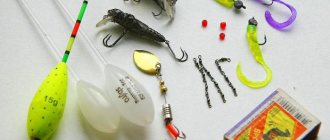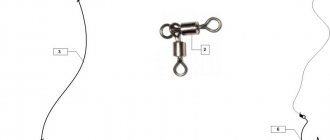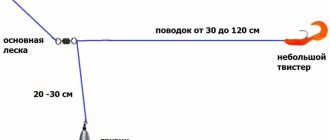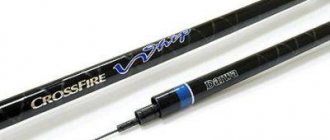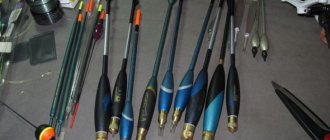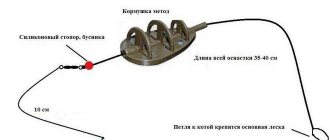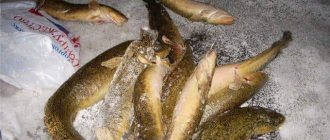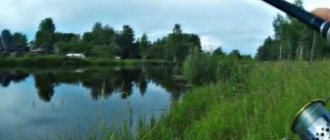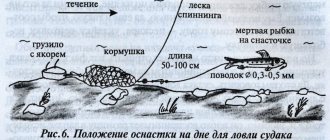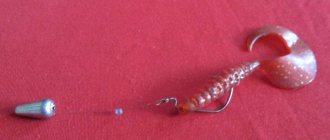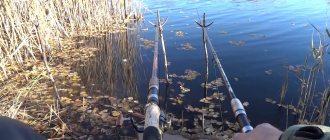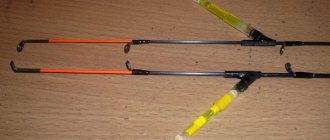Rod
Any rod (plug-in, telescopic) that allows you to change tips is suitable as a rod. Interchangeable tips are called quivertips.
There are:
- quivertype pickers (tops for using rigs without feeders);
- feeder quivertypes (tops for using rigs with feeders).
The length of the rod depends on the distance at which you plan to fish and ranges from 1.8 to 4.5 meters.
Quivertypes are solely responsible for signaling bites. The rod set includes up to 5 tips. They differ from each other in sensitivity (test, power), which is indicated on the form (they may have different colors to indicate power).
Rods differ in power into classes:
- ultra-light,
- easy,
- average,
- heavy,
- super heavy.
For lakes and rivers with weak currents, quivertypes with a swinging spout are used. For rivers with a current, quivertypes have a trembling nose.
Float installation: basic methods
Depending on the places where you plan to fish, choose the type of float attachment.
If you want to install an English donkey for fishing in still water, then a blind mount for the float is required. In this case, its position is determined by the fisherman himself, choosing an option convenient for fishing. To do this, a copper wire is pulled into the lower ring of the float and, by twisting its ends, it is firmly attached to the fishing line.
The second option for blind installation is fastening using two cambrics. The wire itself is not curled, but bent in the form of a loop, bending the edges in one plane.
For fishing in deep reservoirs, where there are places with thickets of reeds and snags, as well as for long casts, sliding equipment is suitable. In this case, the float itself moves between the two stoppers. But for such equipment you must have a certain skill, since the fishing line can often break. Therefore, it is not advisable for beginners to use it.
Do-it-yourself installation diagram and description
There are more than a dozen schemes for equipping English bottom tackle.
There are:
- For installation of cargo (feeder):
- blind installation;
- sliding installation.
- By type of feeder used:
- with an open feeder;
- with a closed feeder (for live food).
- By placing the leash:
- above the load (feeder);
- below the load (feeder).
The simplest and most widespread easy installation of blind rigging is Paternoster , if the rigging is knitted on a separate fishing line. If the equipment is knitted on the main line, then you can mount a Gardner loop ,
How to do it yourself:
- We cut a monofilament line with a diameter of 0.25 - 0.30 mm and a length of 50 - 60 cm.
- We tie a swivel to one end of the fishing line.
- We put a stopper bead through the other end of the fishing line.
- We pass the line through the anti-twist.
- We put on the second stop bead. The anti-twist ends up between the two beads.
- We tie a swivel to the second end of the fishing line.
- We attach a leash to one swivel, and through the second swivel we tie the equipment to the main fishing line.
- We attach a feeder to the anti-twist with a clasp.
Varieties of English donks
Let us recall that a quivertip is a flexible, replaceable tip of a feeder rod. Based on its appearance, the following types of English donkeys are distinguished:
- Picker quivertype - does not include feeders.
- Quivertip feeder – makes it possible to make long casts with fairly heavy feeders and baits.
High-quality rods for bottom fishing are most often made from high-modulus graphite, their component parts are connected using plug-in fasteners, and the handle in most models is made of cork. Their distinctive properties are high sensitivity and reliability.
Along with graphite, budget gear made from composite or fiberglass are quite popular. Any English bottom rod is equipped with three interchangeable tips of different hardness, which are used for fishing in different conditions - in slow, medium and strong currents. When choosing a tip for an English donkey, you need to ensure that its rigidity corresponds not only to the strength of the current, but also to the weight of the intended catch.
Read more
What is a half-bottom with a float and how to use it?
When selecting fishing line, take into account the parameters of the rod and its tip. For picker fishing, the most rational choice would be monofilament, characterized by minimal friction on the rings. For fishing with a heavy feeder rod, it is optimal to use braided fishing line.
Selecting components with the required parameters and assembling feeder gear with your own hands is quite easy, although some novice fishermen prefer to purchase ready-to-use gear in specialized stores in the hope that it was assembled by masters of their craft who know a lot about bottom fishing.
There are more than a dozen equipment schemes for English bottom tackle
Recommendations for installation assembly
As a leash we use monofilament fishing line of a smaller diameter than the fishing line on which the feeder and the main fishing line are attached. It is better to lose the leash than the entire equipment when biting a fish that is too large.
If the installation of the equipment is carried out not on the main fishing line, but on a separate one, then we recommend using monofilament fishing line. The swivels and anti-twist slide better on it.
If a braided cord is used as the main fishing line, then it is better to mount the equipment on a separate monofilament fishing line. The strength of the braided cord should be greater than the strength of the fishing line on which the equipment is tied. When connecting the main line to the rig, it is better to use a swivel rather than connecting loop to loop.
Installation recommendations
The most basic and, perhaps, main recommendation for novice fishermen who decide to choose an English donka is that you should not rush, since the quality of your installation will directly affect your bite. The more carefully you install the equipment, the easier it will be to catch even the largest and smartest fish.
It should also be noted that the fish are not biting too actively. In such cases, the easiest way would be to use several donks at once, which will make the catch more successful.
Try to place the bottom on the side of the water movement, since all the fish are usually located there. By throwing donks into such places, you allow the current to move them to more successful and convenient places for fishing, so don’t be afraid to throw them, as this is much better than not throwing them under.
Keep an eye on the general condition of the water, as many fishermen often sit for several hours and do not have a catch just because they could not choose the right place to fish and the area they chose simply does not have fish.
Use live feeders as well as plant feeders, since fish in different places have their own preferences, which are better to find out immediately at the beginning of fishing, thereby saving yourself time.
Donkey attachments
The attachment for the bottom tackle depends on the type of fish you are going to catch. It could be:
- worm;
- maggot;
- bloodworm;
- corn;
- semolina dough;
- boilies.
During the current, it is better to fish with baits that stay on the hook for a long time. For example, dough on a river will quickly wash out.
You can learn more about catching carp with boilies in a special article, which covers such nuances as their choice, the technique of catching carp with boilies, and selecting the right flavorings.
Feeder equipment paternoster
This is the simplest and most effective installation for a feeder. An English donka of this type is considered a classic and is used for catching various fish. The essence of the installation is to attach the leash above the feeder. For this, the loop method is most often used. It is considered not only the simplest, but also very reliable. It does not require fancy devices, since you can knit directly on the main line.
With proper fastening of the feeding weight, you get an excellent English donk, the installation of which consists of several steps:
- the fishing line is wound on a reel, and its ends are threaded into the rings of the rod;
- measure 0.5-1 m from the tip of the rod and at this distance bend the fishing line in half, making a knot;
- a feeder is attached to the resulting loop;
- A leash (0.4‒0.6 m) with a hook is tied to the remaining piece of fishing line.
It is important to take into account that the length of the leash should be slightly longer than the piece of fishing line that leads to the feeder.
Fishing technique using the example of fishing in a body of standing water
Let's look at the most popular techniques that have proven themselves among fishermen.
Using a marker weight
To search for a promising fishing point, a marker weight is used. A spiked weight is tied to the end of a fishing line and thrown into the water. The distance is about 50 meters from the shore for a fishing rod with a length of 3.60 meters.
Sequencing:
- the fishing line is reeling in,
- by resisting the weight dragging along the bottom, unevenness is determined,
- throwing process: the marker is pulled several times in different directions,
- The most promising point is determined: edge, recess, shells.
A marker weight should be in the box of every feeder fisherman. The first casts when exploring a new place are made only with this informative gadget.
Clipping and depth determination
To fix the fishing point found with the help of a marker weight, a cord clamp and a line with a reel clip are used. Having decided on the place to cast the bait using a marker, the reel bail opens and 2 meters of cord is dropped from the spool and clipped. This action is performed so that the feeder and bait lie after casting in the place found when pulling with a load.
The depth of the reservoir at the casting point is calculated by mentally counting the time the marker is lowered to the bottom; the higher it is, the greater the depth. A clear sign of a promising place when the difference in depth coincides with the obstacles felt when dragging the load.
To fix the distance to the fishing spot, try on the length of the fishing line using available materials. Two pegs are placed with a meter step from each other, a piece of fishing line is wrapped around them, connecting the shore and the fished point in the water.
Rate of feed supply to the fishing point
The frequency of casting is determined by bites. The first casts are made every 2 – 3 minutes. The English donka is a constant bait by regularly supplying a bait mixture to a certain place. After receiving the first bites, feeding continues. Methodically, with each subsequent cast, the next part of the bait is fed in to hold the approaching flock.
The role of correctly selected and installed equipment
The success of your entire fishing trip may depend on the right equipment, which should also be installed correctly. A well-chosen float can not only significantly simplify fishing, but also make it more profitable for the catch. The float should be selected so that it fully suits the conditions in which the fishing will take place.
Most beginners are left without a catch precisely because they are not able to choose the right equipment, which experienced fishermen had to do through trial and error. The float must be firmly attached to the fishing line using one of the existing fastening methods that is most convenient for the fisherman himself.
[custom_ads_shortcode2]
